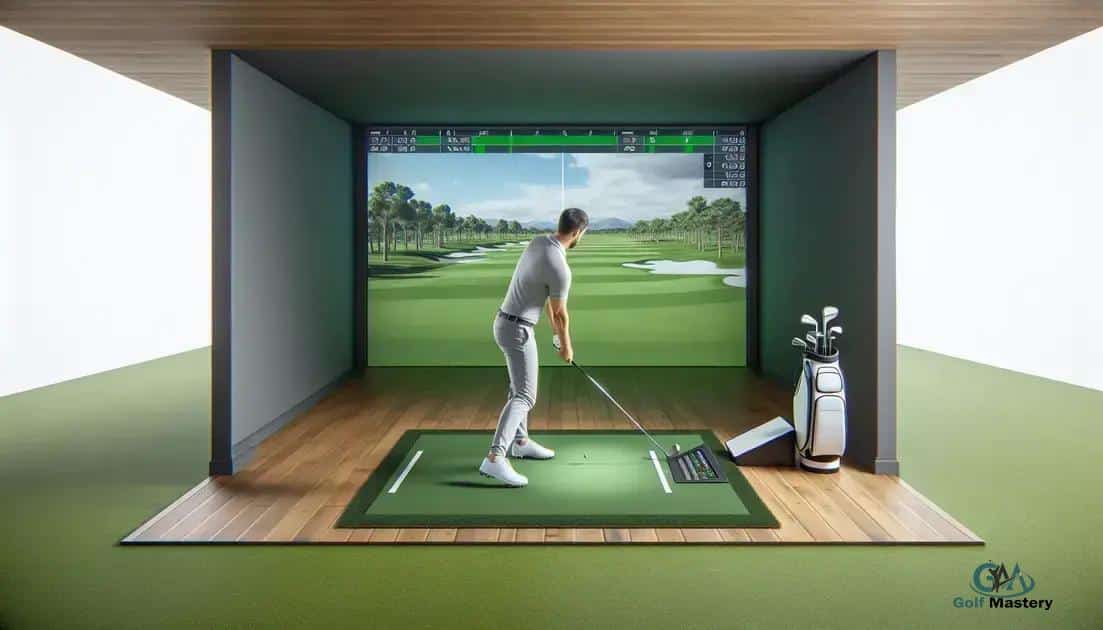How much space needed to swing golf club in sim is crucial for a perfect golf setup. Learn what you need to know!
For an effective golf simulator setup, you should have at least 10 feet of width, 10 feet of length, and 8 feet of height to comfortably swing a golf club. Proper measurements and optimization enhance your practice experience significantly.
If you’re planning to set up the perfect golf simulation at home, understanding how much space is needed to swing a golf club in sim is crucial. Proper spacing not only enhances your game experience but also ensures safety. Whether you’re an amateur or a seasoned player, knowing the essential space requirements can elevate your practice sessions. In this article, we will dive into the various factors that determine the necessary space and provide tips to optimize your golf simulation setup.
Understanding the Swing of a Golf Club
Understanding the swing of a golf club is essential for any golfer, whether you’re a beginner or a pro. A proper swing involves several components that influence both distance and accuracy.
Key Components of a Golf Swing
The golf swing can be divided into various phases, including the takeaway, backswing, downswing, impact, and follow-through. Each phase requires practice and understanding to master.
The Takeaway
The takeaway starts the swing. It’s important to maintain a steady posture and initiate the movement with your shoulders and arms. Keeping the club low and parallel to the ground helps in establishing a smooth motion.
The Backswing
During the backswing, rotate your shoulders while keeping your eyes on the ball. Your hips should also turn, creating a coil that stores energy for the downswing. A good backswing will lead to a powerful shot.
The Downswing
The downswing is where all the energy stored in the backswing is released. Start the downswing by rotating your hips toward the target and letting your arms follow. Timing is crucial; an early or late downswing can impact your shot significantly.
Impact and Follow-through
Impact occurs when the club strikes the ball. Aim to hit the ball with the clubface square for optimal accuracy. Finally, the follow-through is just as important; it helps in maintaining balance and can indicate how well you executed your swing.
By understanding the swing mechanics, players can adjust their stance and body position effectively, ensuring they’re using the appropriate amount of space. This knowledge is essential when setting up your golf simulator, as it helps create the optimal environment for practice.
Importance of Space in Golf Simulations
The importance of space in golf simulations cannot be overstated. Having enough room ensures that players can swing freely without restrictions. A cramped environment can lead to poor swings and even injuries.
Impact on Swing Mechanics
When simulating golf, the ability to move comfortably affects swing mechanics. If you cannot practice your full swing due to limited space, you might develop bad habits that are hard to correct later.
Safety First
Space is crucial for safety when swinging a golf club. Having enough room prevents accidents and damages to furniture or other items in the vicinity, allowing you to focus on your game.
Realistic Practice Environment
A spacious setup replicates the feel of an actual golf course. Players can practice their swings as they would outdoors, leading to a more effective practice session. This allows for better muscle memory and skill retention.
Technology Integration
Many golf simulators require additional equipment, such as monitors and sensors, which also need space. A proper layout can enhance the simulator’s accuracy and functionality, offering a better overall experience.
By ensuring adequate space in your golf simulation setup, you can improve your skills and enjoy a more satisfying practice experience.
Measuring the Required Space
Measuring the required space for your golf simulator is essential for a successful setup. This ensures that you have a comfortable area to swing your club while maximizing your practice time.
Initial Measurements
Start by measuring the area where you plan to install your simulator. A good basis is at least 10 feet wide, 10 feet long, and 8 feet high. This creates enough room for your swing and any additional equipment.
Consider the Swing Radius
The swing radius is crucial. When you take a full swing, the club extends outward. Measure from your stance position to the farthest point of your swing. This should be between 6 to 10 feet, depending on your height and swing style.
Space for Equipment
Don’t forget about the space needed for your simulator equipment, including projectors, screens, and sensor systems. Ensure you leave at least 2 feet behind the hitting area for these devices.
Safety Buffer Zone
A safety buffer zone is essential. You should have at least 3 feet of clearance around your setup to prevent damage or injury. This allows for safe movement and setup adjustments.
Test Your Setup
Once you’ve made your measurements, set up your hitting area and practice swinging to see how it feels. Adjust your layout until you find a comfortable and effective space that works for you.
Common Mistakes in Measuring Space
When measuring space for your golf simulator, it’s easy to make mistakes. Recognizing these common mistakes can help ensure you have the right setup.
Ignoring the Swing Radius
A frequent error is not accounting for the full swing radius. Many players underestimate how much space is needed for their swing, which can lead to a cramped setup. Always measure from your stance to the farthest point of your swing.
Not Considering Equipment Space
Another mistake is failing to include space for necessary equipment. Golf simulators require room for projectors, screens, and sensors. Always allocate at least 2 feet behind the hitting area for these devices.
Underestimating Safety Buffer
Many people neglect to leave enough safety buffer zone around their setup. A space of at least 3 feet is recommended to prevent accidents and ensure comfort while swinging.
Measuring Without Proper Tools
Using inaccurate tools or methods can lead to poor measurements. It’s essential to use a tape measure to get precise dimensions rather than estimating based on visual judgment.
Failing to Test the Setup
Finally, some skip the testing phase after measuring. Always set up your space and swing a few times to ensure it feels comfortable and meets the required space setup before making it permanent.
Tips for Optimizing Your Golf Sim Setup
Optimizing your golf sim setup can greatly enhance your practice experience. Here are some tips to ensure you get the most out of your simulation.
1. Choose the Right Location
Pick a location with sufficient space and minimum distractions. A quiet room allows you to focus on improving your game. Ensure you have enough height and width for a full swing.
2. Adjust Lighting
Proper lighting is crucial for a successful setup. Avoid placing your simulator near windows or glare sources. Soft, diffused lighting will help create a comfortable environment and improve visibility on the screen.
3. Use Quality Equipment
Invest in high-quality simulators and accessories. Infrared sensors or high-speed cameras can make a difference in accuracy. Ensure you also have proper mats that resemble the feel of the fairway or turf.
4. Regularly Update Software
Keep your golf simulator software updated to enhance features and performance. New updates can improve gameplay, accuracy, and provide better analysis of your swing.
5. Personalize Your Setup
Customize your experience by adjusting settings and screen displays. Choose courses and conditions that you find challenging yet enjoyable. This keeps your practice sessions engaging and fun.
Bringing It All Together: Your Ideal Golf Setup
Having the right space to swing your golf club in a simulator directly impacts your practice efficiency and enjoyment. From understanding how to measure the required area to optimizing your simulator setup, each aspect plays a vital role.
Avoiding common mistakes in measurements and creating a safe environment helps in perfecting your swing. Additionally, by implementing smart tips for setup, you can create a realistic and effective practice experience.
With careful planning and attention to detail, you can transform your golf simulation into an invaluable tool for honing your skills and enjoying the game.
FAQ – Frequently Asked Questions About Golf Simulator Space
How much space do I need for my golf simulator?
Typically, at least 10 feet wide, 10 feet long, and 8 feet high is recommended to comfortably swing a club.
What is the swing radius, and why is it important?
The swing radius is the distance your club travels during a swing. It is crucial to measure this accurately to prevent restrictions in your practice area.
How can I measure the required space for my setup?
Use a tape measure to determine the width, length, and height. Make sure to include clearances for equipment and a safety buffer zone.
What are common mistakes when measuring space for a simulator?
Common mistakes include ignoring the swing radius, not considering equipment space, and failing to leave enough safety buffer.
What tips can I follow to optimize my golf simulator setup?
Choose a quiet location, adjust lighting properly, use quality equipment, keep your software updated, and personalize your setup to enhance your practice experience.
Why is having enough space important for a golf simulator?
Having enough space ensures a comfortable swing, prevents accidents, and creates a realistic training environment, making practice more effective.






Leave a Reply